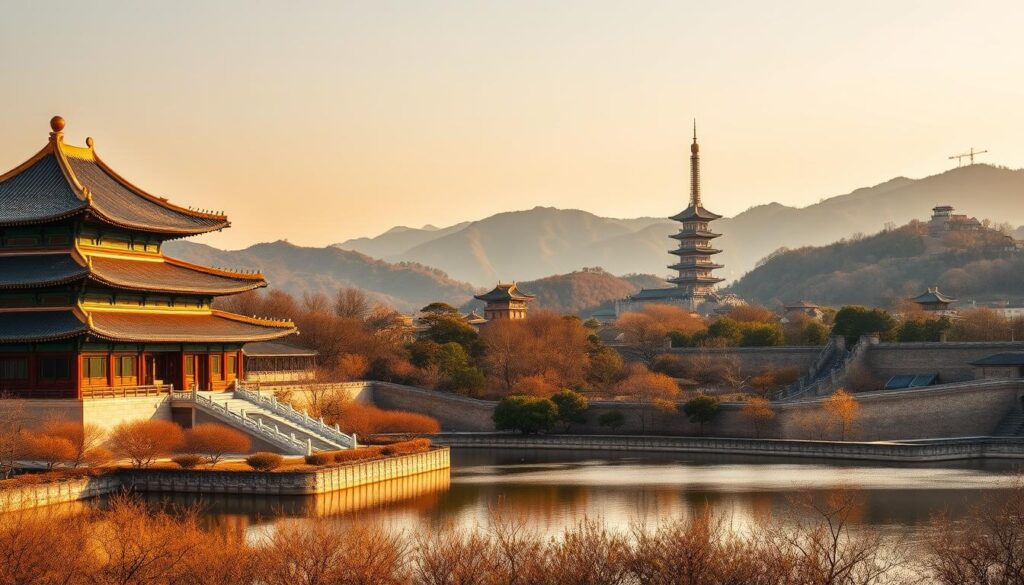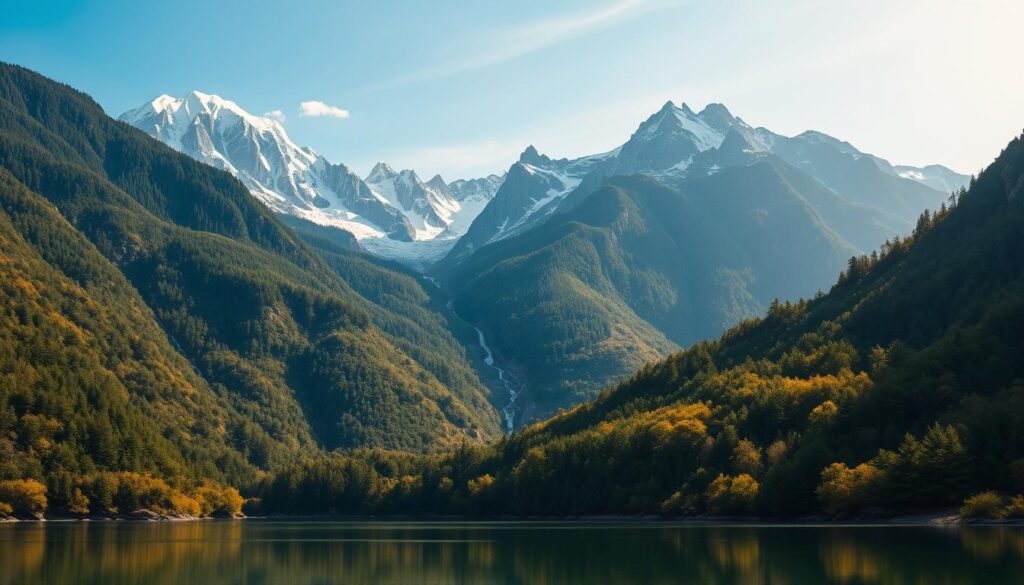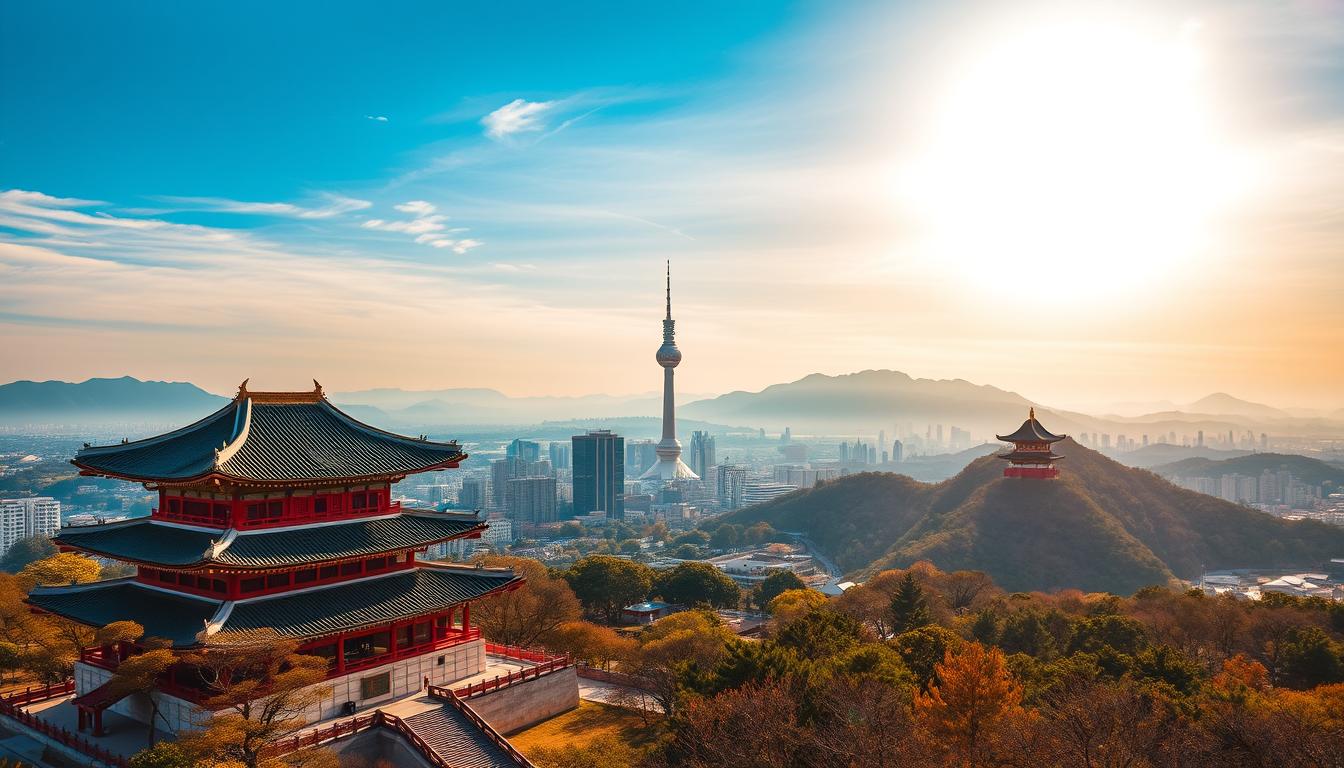The Most Popular South Korea Sites to Visit on Your Next Trip 2025
Table of Contents
Imagine a journey that mixes ancient traditions with modern technology. South Korea has many amazing sites to see that will amaze you and leave lasting memories. You’ll see stunning natural views and lively cities, making your trip unforgettable.
The Most Popular South Korea Sites to Visit on Your Next Trip, your travel guide shows a country where old temples meet new skyscrapers. You can visit places like Jeju Island’s volcanic landscapes or Seoul’s busy streets. This variety makes South Korea a great place for all kinds of travelers.
South Korea is small and easy to get around, thanks to its good transport system. You can see cultural sites, beautiful parks, or exciting cities. There’s something for everyone to enjoy.
Prepare for a trip that’s truly special. Here, old and new come together, making your visit unique. You’ll find surprises, friendly people, and memories that will stay with you forever.
Exploring Seoul: South Korea’s Dynamic Capital
Seoul is a city where old traditions meet modern life. It’s a top spot in South Korea to see history and culture. Your trip to South Korea isn’t complete without seeing Seoul’s special charm.
Seoul has over 9.7 million people, making it a unique urban adventure. It has many attractions for all kinds of travelers.
Historical Palaces and Traditional Neighborhoods
Learn about Seoul’s history at its amazing sites:
- Changdeokgung Palace: A UNESCO World Heritage site
- Gyeongbokgung Palace: The largest royal palace in Korea
- Bukchon Hanok Village: A preserved traditional Korean neighborhood
Modern Districts and Shopping Experiences
Seoul also has a modern side. Check out trendy areas that show Korea’s new ideas:
- Gangnam District: The epitome of modern Korean culture
- Hongdae: A vibrant area known for street art and youth culture
- Myeongdong: A shopping paradise with countless retail options
| Travel Expense Category | Average Cost (USD) |
|---|---|
| Daily Budget | $50 – $200 |
| Street Food Meal | $5 – $10 |
| Hostel Accommodation | $20 – $30 per night |
| Public Transportation | $5 per day |
Cultural Landmarks and Museums
Explore Korean culture at top museums and landmarks:
- National Museum of Korea
- War Memorial of Korea
- N Seoul Tower
Pro tip: Use the T-money card for convenient transportation and save money while exploring the city’s incredible attractions.
Busan: Where City Meets Sea
Busan is a top spot in South Korea, blending city life with coastal beauty. It’s a must-see in your South Korea travel guide. This vibrant city by the sea is unforgettable.
The coast of Busan is stunning, with seven public beaches. Haeundae Beach is the most famous. It draws visitors all year with its white sands and lively vibe.
- Explore Gwangalli Beach, a trendy spot for Busan’s youth
- Visit Songjeong Beach, home to Korea’s first surf school
- Experience the colorful Gamcheon Culture Village
“Busan is where urban energy meets oceanic tranquility” – Local Tourism Board
The city’s food scene is amazing too. Jagalchi Fish Market offers fresh seafood. The city also got Michelin stars, showing its top-notch food.
| Attraction | Unique Feature |
|---|---|
| Busan International Film Festival | Annual event, UNESCO Creative City of Film |
| Spa Land | 13 themed sauna and steam rooms |
| Busan Green Railway | 3-mile scenic coastal walking path |
Busan offers culture, beach fun, and city adventures. It’s a journey you won’t forget in South Korea’s coastal metropolis.
Jeju Island: Natural Wonders and Coastal Beauty
Discover Jeju Island, known as the “Hawaii of Korea.” It’s a top spot in South Korea for those who love nature and unique experiences. This place has volcanic landscapes, beautiful beaches, and a rich culture, making it a hidden gem.
Located off Korea’s southern coast, Jeju Island is home to amazing geological wonders. Hallasan Mountain, the highest peak in South Korea, stands at 1,947 meters. It’s a UNESCO World Heritage Site and a top spot for hiking.
Volcanic Landscapes and UNESCO Sites
Jeju’s volcanic past creates stunning scenery. Key attractions include:
- Seongsan Ilchulbong (Sunrise Peak), a 100,000-year-old volcanic crater
- Manjanggul Lava Tube, stretching over 13 kilometers
- Unique geological formations showing the island’s volcanic history
Beach Activities and Water Sports
Beach lovers will enjoy Jeju’s clear waters and diverse coastlines. Visit Udo Island for its white coral beaches or try water sports along the coast.
Local Culture and Cuisine
Dive into Jeju’s culture by trying local foods like black pork and visiting traditional villages. The island’s unique heritage, including its matriarchal society, offers a glimpse into Korean traditions.
Jeju Island is perfect for those looking for natural wonders, cultural experiences, or just to relax. It’s an unforgettable part of your South Korea travel adventure.
Must-Visit South Korea Sites for History Lovers

If you love history, South Korea is a treasure trove of stories. Your travel guide to South Korea must include these iconic landmarks. They show the deep cultural heritage of the country.
The Korean peninsula is full of sites for history buffs. Each place has its own story of strength, change, and culture.
- Gyeongbokgung Palace: A stunning representation of Joseon Dynasty architecture
- Korean Demilitarized Zone (DMZ): A profound historical landmark symbolizing national division
- Changdeokgung Palace: A UNESCO World Heritage site with extraordinary historical significance
The DMZ is a powerful reminder of Korea’s complex past. It’s about 4 kilometers wide. Guided tours here give deep insights into the country’s political history.
“History is not just about the past, but understanding the journey that shaped a nation.” – Korean Historical Preservation Society
Changdeokgung Palace is huge, covering 78 acres. Its Secret Garden has ancient trees, ponds, and structures. It feels like stepping back in time.
Visiting these sites is more than seeing old buildings. They connect you to South Korea’s rich culture. They’re must-see places on your trip.
Gyeongju: The Museum Without Walls
Discover one of the best places in South Korea, a city that breathes history with every stone. Gyeongju stands as a living museum, giving travelers a unique sightseeing experience through an ancient kingdom’s landscape.
As the former capital of the Silla Kingdom, Gyeongju presents landmarks that take you back over 2,000 years. It’s called “Museum Without Walls” for its amazing collection of historical treasures across its landscapes.
Ancient Temples and Royal Heritage
Explore UNESCO World Heritage Sites that show Gyeongju’s cultural importance:
- Bulguksa Temple, built in A.D. 751
- Seokguram Grotto, a stunning Buddhist architecture
- Daereungwon Tomb Complex, with huge royal burial mounds
Archaeological Wonders
The city’s archaeological richness is stunning. The Cheomseongdae Observatory, the oldest astronomical site in East Asia, shows Silla’s advanced science.
| Site | Historical Significance | Admission Price |
|---|---|---|
| Cheomseongdae Observatory | Oldest East Asian astronomical observatory | Adults W4,000 |
| Wolji Pond | Royal palace garden from A.D. 674 | Adults W2,000 |
| National Museum of Gyeongju | Houses 80,000 historical relics | Free admission |
Traditional Architecture
Walk through the city’s preserved traditional architecture. See hanok houses and ancient temple structures that show Silla’s elegant design.
Pro tip: Spend at least two to three days exploring Gyeongju’s historical landscape. It’s close to Busan, just an hour and a half away, making it easy to add to your South Korean trip.
Natural Attractions and National Parks
South Korea’s landscape is full of breathtaking natural spots. These hidden gems are perfect for travelers looking for unique experiences. Your south korea travel guide wouldn’t be complete without visiting the country’s stunning national parks and ecological wonders.

Explore the incredible variety of South Korea’s natural sites. From volcanic islands to lush mountain ranges, there’s something for everyone. Seoraksan National Park is a UNESCO biosphere reserve with dramatic peaks and diverse ecosystems. It’s 1,708 meters high, with stunning hiking trails and breathtaking views.
- Jeju Island: A volcanic paradise with 26 islets and 60 lava caves
- Mount Hallasan: South Korea’s highest mountain with a stunning crater lake
- Manjanggul Lava Tube: An extraordinary 13,400-meter underground geological wonder
- Upo Wetlands: A 2.3 square kilometer wildlife sanctuary
When planning your south korea sites to visit, don’t miss these natural wonders. The Taebak Mountains are the source of two important rivers. Coastal areas like Suncheon Bay offer unique ecological experiences with migrating birds.
| Natural Site | Unique Feature | Location |
|---|---|---|
| Seoraksan National Park | UNESCO Biosphere Reserve | Gangwon Province |
| Jeju Island | Volcanic Landscape | Southern Coast |
| Upo Wetlands | Migratory Bird Habitat | South Gyeongsang Province |
Dive into South Korea’s natural beauty. Every landscape has a story of geological wonder and ecological richness.
Cultural Experiences in Traditional Villages
Explore the heart of Korean heritage in South Korea’s traditional villages. These hidden gems give a real look into the country’s rich culture. They are key stops on any South Korea sightseeing trip.
Walk through a living museum where history comes alive. Every street and traditional hanok house tells a story. Places like Bukchon Hanok Village in Seoul and Jeonju Hanok Village show off Korea’s cultural traditions.
Folk Customs and Traditional Performances
Dive into the world of Korean culture. These villages let you see traditional performances that bring old customs to life.
- Join in on authentic darye tea ceremonies
- See amazing mask dances
- Enjoy traditional music shows
Local Crafts and Architecture
Traditional villages let you get hands-on with Korea’s artisanal heritage. You’ll find workshops where you can see amazing craftsmanship in traditional arts.
| Craft | Location | Experience Type |
|---|---|---|
| Pottery (Onggi) | Insadong, Seoul | Hands-on Workshop |
| Hanji Paper Making | Jeonju Hanok Village | Artisan Demonstration |
| Bojagi Crafting | Gyeongju Cultural Center | Traditional Textile Workshop |
Authentic Korean Lifestyle
Stay in a traditional hanok for a deep cultural experience. These places offer more than a place to sleep. They take you on a cultural journey.
- Try on a traditional hanbok for photos
- Join meditation sessions
- Learn about Buddhist culture
Your visit to these villages will change how you see Korean culture. You’ll make memories that go beyond usual tourist experiences.
Modern Entertainment and Urban Attractions
Exploring South Korea’s top spots reveals a world of modern fun. Seoul and Busan lead the way with their urban adventures. They offer a deep dive into South Korea’s lively contemporary scene.
Theme parks like Everland Resort and Lotte World are the heart of Korean fun. They boast exciting rides, shows, and unique experiences. These spots are a must-see, attracting millions every year.
K-pop and Korean drama fans will love Seoul’s entertainment areas. You can visit K-pop cafes, music studios, and shopping spots like Myeongdong. It’s a chance to dive into South Korea’s pop culture phenomenon.
For tech lovers, places like the Seoul Sky Observatory and Dongdaemun Design Plaza are a must. They show South Korea’s tech skills. These spots offer a peek into a culture that mixes innovation with everyday life, making your trip unforgettable.
FAQ
What is the best time to visit South Korea?
Do I need a visa to travel to South Korea?
How efficient is public transportation in South Korea?
What are the must-try foods in South Korea?
Is English widely spoken in South Korea?
What should I know about Korean cultural etiquette?
How safe is South Korea for tourists?
What is the currency in South Korea, and can I use credit cards?
What unique experiences can I have in South Korea?
How can I get around between different cities in South Korea?
Source Links
- Top 28 Places In South Korea In 2025 That Bring Out The Vibrant Charm Of The Exotic Nation – https://traveltriangle.com/blog/places-to-visit-in-south-korea/
- 14 Days in South Korea: Must-See Attractions and Best Things to Do – Klook Travel Blog – https://www.klook.com/blog/must-see-attractions-south-korea/
- Seoul Travel Guide 2025: The Ultimate First-Timer’s Guide to South Korea’s Dynamic Capital – https://www.realjourneytravels.com/seoul-travel-guide/
- Seoul: EXO’s guide to Korea’s dynamic capital – EXO Travel Blog – https://www.exotravel.com/blog/en/seoul-city-guide/
- 8 things to see and do in Busan, South Korea – https://www.nationalgeographic.com/travel/article/best-things-to-do-busan-south-korea
- No title found – https://www.visitbusan.net/index.do?lang_cd=en&menuCd=DOM_000000302002001000&uc_seq=1409
- Jeju Island: A Journey Through South Korea’s Natural Wonders | Indian Ocean Islands – https://www.islaguru.com/articles/jeju-island-a-journey-through-south-koreas-natural-wonders
- Jeju Island Travel Guide: Discover the Hawaii of Korea – https://www.magnificentworld.com/things-to-do-in-jeju-island/
- Discovering Jeju: Must-Visit Tourist Sites on South Korea’s Island Paradise – https://medium.com/noorey/discovering-jeju-must-visit-tourist-sites-on-south-koreas-island-paradise-98fbe56ada1e
- Top 10 Must-Visit Tourist Destinations in South Korea in 2025 – https://www.gokite.travel/tourist-destinations-in-south-korea/
- 10 Best Tourist Sights in South Korea You Can’t Miss – https://www.myodysseytours.com/south-korea/tourist-sights.html
- South Korea’s ‘Museum Without Walls’ Is A Unique City Brimming With Buddhist Temples And Palaces – Islands – https://www.islands.com/1757784/south-korea-golden-city-gyeongju-brims-buddhist-temples-palaces-like-kyoto/
- A Guide To Gyeongju, Korea: What To Do, See, Eat & Where To Stay – https://thesoulofseoul.net/gyeongju-korea-guide/
- 8 Best Natural Attractions in South Korea – https://www.odynovotours.com/south-korea/best-natural-attractions.html
- Nature Detour: 9 Stunning Natural Attractions to Visit in South Korea – https://www.tripzilla.com/south-korea-natural-attractions/41118
- 5 Immersive Cultural Experiences in Korea – https://www.adventure.travel/stories/5-immersive-experiences-in-korea
- Korea Information – Tourism — Korean Cultural Center New York – https://www.koreanculture.org/korea-information-tourism
- 21 Unmissable Things to Do in South Korea on Your First Trip – Klook Travel Blog – https://www.klook.com/en-US/blog/south-korea-bucket-list/
- Top tourist destinations in South Korea you shouldn’t miss | – The Times of India – https://timesofindia.indiatimes.com/life-style/travel/destinations/top-tourist-destinations-in-south-korea-you-shouldnt-miss/articleshow/117953819.cms
- Top 10 Tourist Attractions in South Korea: Festivals & Fun! » Agoda: See The World For Less – https://www.agoda.com/travel-guides/south-korea/top-10-tourist-attractions-in-south-korea-festivals-fun/

